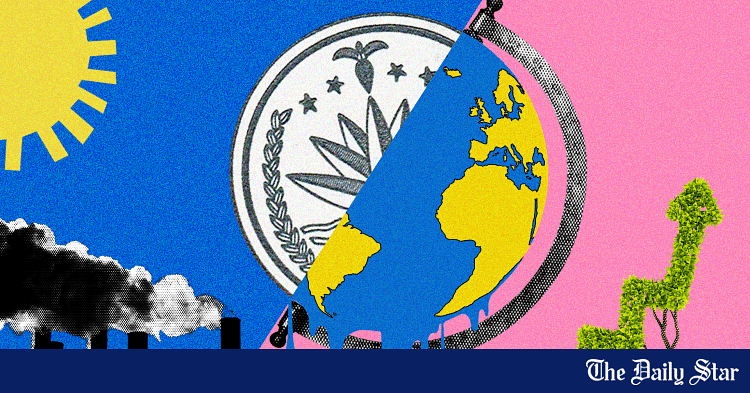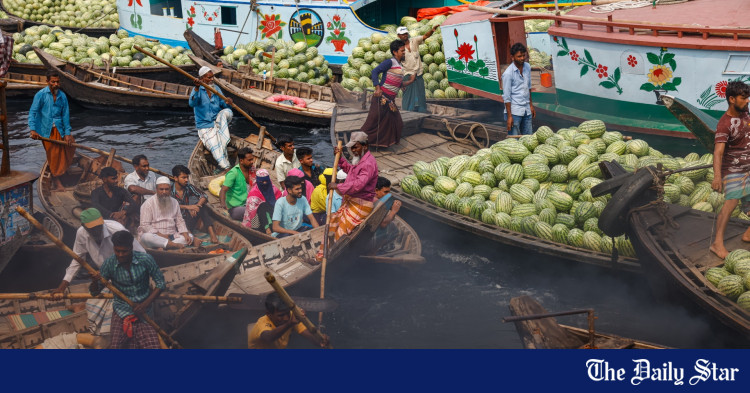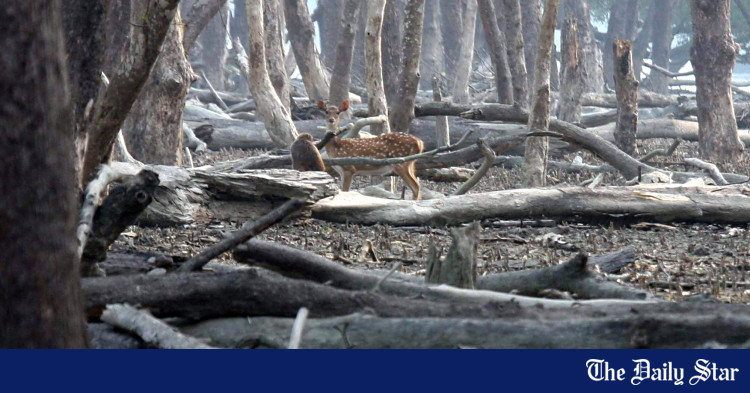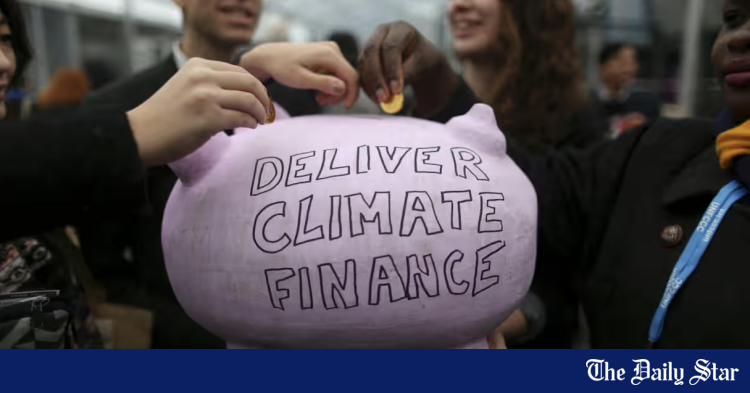- Copy to clipboard
- Thread starter
- #161
Saif
Senior Member
- Joined
- Jan 24, 2024
- Messages
- 15,397
- Reaction score
- 7,869
- Nation

- Residence

- Axis Group


Role of youth in fight against air pollution
AMID the lingering haze over Bangladesh’s cities, air pollution has become an escalating public health crisis. From brick kilns to traffic congestion, harmful pollutants seep into every aspect of urban life, making this not just a climate issue but a matter of human survival. These fine...
 www.newagebd.net
www.newagebd.net
Role of youth in fight against air pollution
Fahmida Farzana and Abdullah M Rafi 31 October, 2024, 00:00

Dust covers the main road at Shyampur in the capital Dhaka, one of the most polluted cities in the world. | New Age/Sony Ramany
AMID the lingering haze over Bangladesh’s cities, air pollution has become an escalating public health crisis. From brick kilns to traffic congestion, harmful pollutants seep into every aspect of urban life, making this not just a climate issue but a matter of human survival. These fine particulate matters — dust, soot, and smoke — can penetrate the lungs and bloodstream, posing severe health risks. A study by the University of Chicago’s Energy Policy Institute shows that air pollution is reducing the average life expectancy in Bangladesh by 6.8 years. The most vulnerable group — children, pregnant women, and low-income communities — are bearing the heaviest burden of this invisible threat.
Bangladesh’s youth are particularly at risk. Their daily commutes, reliance on crowded public transportation, and outdoor activities expose them to higher levels of pollutants, putting them at increased risk of respiratory diseases and long-term cognitive impairments. Despite government initiatives, air quality in cities as Dhaka remains critically poor, partly due to gaps in enforcement and the need for a broader multisectoral effort.
The health impacts of air pollution extend beyond respiratory diseases. There is growing evidence linking air pollution to non-communicable diseases such as cardiovascular disease, diabetes, and cognitive disorders such as dementia. Tackling these requires a stronger healthcare system.
As Bangladesh grapples with the consequences of poor air quality, it is the youth who can step forward, not only as victims but also as catalysts for change. Their leadership in climate action and public awareness is critical to safeguarding the health and future of the next generation, offering a path toward a healthier, more sustainable Bangladesh.
Air pollution’s dual threat
AIR pollution plagues both outdoor and indoor air in Bangladesh, giving rise to a two-pronged public health crisis. Indoor air pollution, largely caused by the burning of biomass fuels such as wood, dung, and crop residues for cooking, emits pollutants including PM2.5 and also volatile organic compounds.
Women and children spend a large amount of time in poorly ventilated spaces, increasing their vulnerability to respiratory disease since standing still for long periods allows these potential contaminants to stew. A well-known science journal, The Lancet, in 2019 showed that households that use biomass fuels are twice as likely to cause pneumonia to children under five. In Bangladesh, over 75 per cent of households continue to use solid fuels for cooking, leading to over 94,800 deaths from indoor air pollution in 2019, with 12 per cent of infant deaths also linked to household air pollution, according to the State of Global Air 2020.
Furthermore, secondhand smoking of tobacco at home is one of the biggest contributors to poor indoor air quality. A study by the ARK Foundation, conducted in collaboration with The University of York, revealed that 92 per cent of children studied were exposed to secondhand smoke at home. Here it has been highlighted that the prolonged exposure significantly raises the risk of respiratory infections and long-term health issues, such as poor academic performance and an increased likelihood of smoking later in life. With only 38.5 per cent of homes being completely smoke-free, the study calls for the urgent need to reduce SHS exposure.
Outdoor air pollution remains a major concern, particularly in urban areas. Vehicles, industries, and construction also contribute significantly to elevated levels of pollutants such as PM2.5, nitrogen oxides, and sulphur dioxide. According to the Bangladesh Road Transport Authority 2022 report, Dhaka ranks near the bottom in terms of air quality, with 1.5 million vehicles, the majority of which are deteriorating, adding to the problem. This is exacerbated by inadequate regulations on pollution and poor transportation infrastructure.
Moreover, brick kilns are an important contributor to outdoor pollution. According to the World Bank’s South Asia Air Quality Management Report 2020, Bangladesh has approximately 7000 coal-fired brickkilns that account for more than 40 per cent of PM2.5 emissions in Dhaka. These emissions are major causes of poor respiratory health in urban areas, including Rajshahi, where asthma and other forms of lung illness are on the rise.
Comprehensive measures such as the adoption of cleaner cooking technology, the reduction of secondhand smoke exposure, and the implementation of more durable vehicle emissions regulations for on-road cars to reduce both the air pollution sources are burning needs right now.
Health impacts
THE effects of air pollution are profound, particularly among vulnerable populations, including children, pregnant women, and low- and middle-income communities. Respiratory and cardiovascular diseases are associated with exposure to PM2.5, NOx, and SO2. Over 10 per cent of children living in urban areas such as Dhaka, Gazipur, and Chattogram suffer from severe respiratory diseases primarily due to exposure to air pollution.
Pregnant mothers are more likely to face preterm deliveries, low birth weight, and developmental impairments in their children as a result of extended PM2.5 exposure. Women in LMI communities are particularly vulnerable since they are exposed to both indoor biomass toxins and outdoor automobile emissions. Limited access to healthcare exacerbates these risks, further marginalising existing vulnerable individuals, as stated in the UNICEF Bangladesh Health Report 2022.
Beyond physical health, air pollution has a profound impact on mental health. Children exposed to high amounts of pollution are more likely to develop anxiety, depression, and cognitive deficits. These mental health difficulties exacerbate the already heavy burden of physical diseases in densely polluted metropolitan settings.
Air quality management
TO COMBAT pollution, the government of Bangladesh has enacted laws such as the Air Pollution Control Rules 2022 and the Brick Manufacturing Control Act; however, enforcement remains inadequate. The paper highlights that limited resources for monitoring and enforcing air quality regulations lead to significant gaps, especially in densely populated, low-income urban areas.
The absence of coordination among government organisations hinders air quality control efforts. Resource and staffing shortages hinder regular inspections, particularly in the Department of Environment, allowing polluting industries and unregulated brick kilns to operate unchecked.
The Air Quality Index is monitored by the DoE and international partners such as the US Embassy in Dhaka; however, real-time data access and monitoring system accuracy remain limited. Despite progress under the Clean Air and Sustainable Environment project, issues with enforcement and public access to data persist.
Role of youth in climate action
YOUTHS are not only the primary sufferers of the air pollution but the crucial agents of change. They participate in more outdoor activities and commute, exposing them to larger amounts of pollutants. Communities have been organised by youth-led efforts such as Fridays for Future Bangladesh and the Bangladesh Youth Environmental Initiative to urge for stronger implementation of air quality regulations. Young leaders have launched awareness campaigns, organised protests, and pushed for cleaner technologies to increase the reduction of air pollution, according to the Fridays for Future Bangladesh 2023 Action Plan.
Furthermore, university students have come up with inexpensive air cleaners and eco-friendly cooking stoves to fight indoor and outdoor pollution. Their innovations are significant in mitigating health hazards among the LMI communities exposed to the high level of air pollution. Youth-led activism has also been enhanced by organisations including UNICEF and UN-Habitat, who have provided them with opportunities to present their solutions and get hands-on experiences on international platforms, as reported by the UN-Habitat Youth Initiatives Report 2023.
To conclude, we can hope that while Bangladesh faces one of its most serious public health crises, the government will step up its effort and collaborate with non-governmental organisations to strengthen healthcare institutions and promote community resilience. While much work remains, if the government, NGOs, and youth-led groups work together, they can very well achieve cleaner air and better public health outcomes for all our citizens. It is the time to breathe hope into the air and empower the next generations.
Fahmida Farzana and Abdullah M Rafi work for the ARK Foundation, Bangladesh
Fahmida Farzana and Abdullah M Rafi 31 October, 2024, 00:00
Dust covers the main road at Shyampur in the capital Dhaka, one of the most polluted cities in the world. | New Age/Sony Ramany
AMID the lingering haze over Bangladesh’s cities, air pollution has become an escalating public health crisis. From brick kilns to traffic congestion, harmful pollutants seep into every aspect of urban life, making this not just a climate issue but a matter of human survival. These fine particulate matters — dust, soot, and smoke — can penetrate the lungs and bloodstream, posing severe health risks. A study by the University of Chicago’s Energy Policy Institute shows that air pollution is reducing the average life expectancy in Bangladesh by 6.8 years. The most vulnerable group — children, pregnant women, and low-income communities — are bearing the heaviest burden of this invisible threat.
Bangladesh’s youth are particularly at risk. Their daily commutes, reliance on crowded public transportation, and outdoor activities expose them to higher levels of pollutants, putting them at increased risk of respiratory diseases and long-term cognitive impairments. Despite government initiatives, air quality in cities as Dhaka remains critically poor, partly due to gaps in enforcement and the need for a broader multisectoral effort.
The health impacts of air pollution extend beyond respiratory diseases. There is growing evidence linking air pollution to non-communicable diseases such as cardiovascular disease, diabetes, and cognitive disorders such as dementia. Tackling these requires a stronger healthcare system.
As Bangladesh grapples with the consequences of poor air quality, it is the youth who can step forward, not only as victims but also as catalysts for change. Their leadership in climate action and public awareness is critical to safeguarding the health and future of the next generation, offering a path toward a healthier, more sustainable Bangladesh.
Air pollution’s dual threat
AIR pollution plagues both outdoor and indoor air in Bangladesh, giving rise to a two-pronged public health crisis. Indoor air pollution, largely caused by the burning of biomass fuels such as wood, dung, and crop residues for cooking, emits pollutants including PM2.5 and also volatile organic compounds.
Women and children spend a large amount of time in poorly ventilated spaces, increasing their vulnerability to respiratory disease since standing still for long periods allows these potential contaminants to stew. A well-known science journal, The Lancet, in 2019 showed that households that use biomass fuels are twice as likely to cause pneumonia to children under five. In Bangladesh, over 75 per cent of households continue to use solid fuels for cooking, leading to over 94,800 deaths from indoor air pollution in 2019, with 12 per cent of infant deaths also linked to household air pollution, according to the State of Global Air 2020.
Furthermore, secondhand smoking of tobacco at home is one of the biggest contributors to poor indoor air quality. A study by the ARK Foundation, conducted in collaboration with The University of York, revealed that 92 per cent of children studied were exposed to secondhand smoke at home. Here it has been highlighted that the prolonged exposure significantly raises the risk of respiratory infections and long-term health issues, such as poor academic performance and an increased likelihood of smoking later in life. With only 38.5 per cent of homes being completely smoke-free, the study calls for the urgent need to reduce SHS exposure.
Outdoor air pollution remains a major concern, particularly in urban areas. Vehicles, industries, and construction also contribute significantly to elevated levels of pollutants such as PM2.5, nitrogen oxides, and sulphur dioxide. According to the Bangladesh Road Transport Authority 2022 report, Dhaka ranks near the bottom in terms of air quality, with 1.5 million vehicles, the majority of which are deteriorating, adding to the problem. This is exacerbated by inadequate regulations on pollution and poor transportation infrastructure.
Moreover, brick kilns are an important contributor to outdoor pollution. According to the World Bank’s South Asia Air Quality Management Report 2020, Bangladesh has approximately 7000 coal-fired brickkilns that account for more than 40 per cent of PM2.5 emissions in Dhaka. These emissions are major causes of poor respiratory health in urban areas, including Rajshahi, where asthma and other forms of lung illness are on the rise.
Comprehensive measures such as the adoption of cleaner cooking technology, the reduction of secondhand smoke exposure, and the implementation of more durable vehicle emissions regulations for on-road cars to reduce both the air pollution sources are burning needs right now.
Health impacts
THE effects of air pollution are profound, particularly among vulnerable populations, including children, pregnant women, and low- and middle-income communities. Respiratory and cardiovascular diseases are associated with exposure to PM2.5, NOx, and SO2. Over 10 per cent of children living in urban areas such as Dhaka, Gazipur, and Chattogram suffer from severe respiratory diseases primarily due to exposure to air pollution.
Pregnant mothers are more likely to face preterm deliveries, low birth weight, and developmental impairments in their children as a result of extended PM2.5 exposure. Women in LMI communities are particularly vulnerable since they are exposed to both indoor biomass toxins and outdoor automobile emissions. Limited access to healthcare exacerbates these risks, further marginalising existing vulnerable individuals, as stated in the UNICEF Bangladesh Health Report 2022.
Beyond physical health, air pollution has a profound impact on mental health. Children exposed to high amounts of pollution are more likely to develop anxiety, depression, and cognitive deficits. These mental health difficulties exacerbate the already heavy burden of physical diseases in densely polluted metropolitan settings.
Air quality management
TO COMBAT pollution, the government of Bangladesh has enacted laws such as the Air Pollution Control Rules 2022 and the Brick Manufacturing Control Act; however, enforcement remains inadequate. The paper highlights that limited resources for monitoring and enforcing air quality regulations lead to significant gaps, especially in densely populated, low-income urban areas.
The absence of coordination among government organisations hinders air quality control efforts. Resource and staffing shortages hinder regular inspections, particularly in the Department of Environment, allowing polluting industries and unregulated brick kilns to operate unchecked.
The Air Quality Index is monitored by the DoE and international partners such as the US Embassy in Dhaka; however, real-time data access and monitoring system accuracy remain limited. Despite progress under the Clean Air and Sustainable Environment project, issues with enforcement and public access to data persist.
Role of youth in climate action
YOUTHS are not only the primary sufferers of the air pollution but the crucial agents of change. They participate in more outdoor activities and commute, exposing them to larger amounts of pollutants. Communities have been organised by youth-led efforts such as Fridays for Future Bangladesh and the Bangladesh Youth Environmental Initiative to urge for stronger implementation of air quality regulations. Young leaders have launched awareness campaigns, organised protests, and pushed for cleaner technologies to increase the reduction of air pollution, according to the Fridays for Future Bangladesh 2023 Action Plan.
Furthermore, university students have come up with inexpensive air cleaners and eco-friendly cooking stoves to fight indoor and outdoor pollution. Their innovations are significant in mitigating health hazards among the LMI communities exposed to the high level of air pollution. Youth-led activism has also been enhanced by organisations including UNICEF and UN-Habitat, who have provided them with opportunities to present their solutions and get hands-on experiences on international platforms, as reported by the UN-Habitat Youth Initiatives Report 2023.
To conclude, we can hope that while Bangladesh faces one of its most serious public health crises, the government will step up its effort and collaborate with non-governmental organisations to strengthen healthcare institutions and promote community resilience. While much work remains, if the government, NGOs, and youth-led groups work together, they can very well achieve cleaner air and better public health outcomes for all our citizens. It is the time to breathe hope into the air and empower the next generations.
Fahmida Farzana and Abdullah M Rafi work for the ARK Foundation, Bangladesh
















